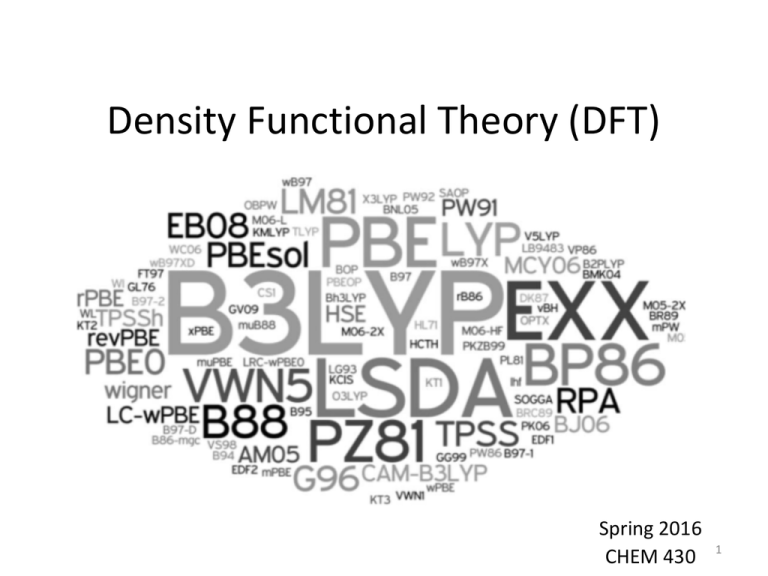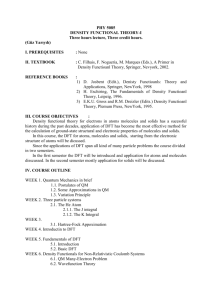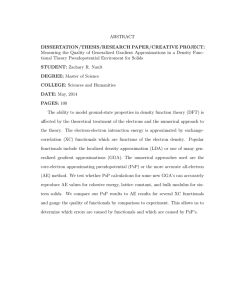Density Functional Theory (DFT) Presentation
advertisement

Density Functional Theory (DFT) Spring 2016 CHEM 430 1 Method selection 100 fs, 10 atoms: photochemistry Correlated Method (MP2, CCSD) Molecular detail Atomistic MM 10 ms, thousands of atoms: protein folding, drug binding Density Functional Theory 10 ps, 100 atoms: chemical reactions Coarse-grain 1 ms+, 1 million atoms: dynamics of large proteins, cell membranes, viruses Computational cost 2 Approximate solutions to Schrödinger equation Schrödinger’s equation is nearly impossible to solve, so approximate methods are used. 2 æ Ñ ç -å i - å Z I + å 1 ç è i 2 i,I R I - r̂i i¹ j r̂i - r̂j HF 1 1 2 1 ö ÷ Y ( ri ) = EY ( ri ) ÷ ø 1 2 1 N 2 2 2 N N 1 N 2 N N Slater determinant: Use wavefunction of noninteracting electrons for interacting system 0 r 0 r1 , r2 , r3 ,, rN E Density functional theory: The ground-state electron density contains all information in the ground-state wavefunction • Electron repulsion makes this problem difficult • Approach 1: Use approximate wavefunction forms (QM) • Approach 2: Use the electron density as the main variable (DFT) • Approach 3: Approximate the energy using empirical functions (MM) E ( R I ) ® kIJ ( RIJ - RIJ0 ) 2 Molecular mechanics: Use empirical functions and parameters to describe the energy (e.g. harmonic oscillator for chemical 3 bond) Scaling Method and basis set Number of basis functions CBS “Exact” solution to HΨ=E Ψ 6Z 5Z QZ TZ DZ Hartree-Fock MP2 DFT CCSD CCSD(T) Full CI Increasing Cost • Scaling • Memory, computer processing time 4 Electron density • Basic premise of DFT: All the intricate motions and pair correlations in a many-electron system are somehow contained in the total electron N density alone (r ) i (r ) 2 i 1 • By locating cusps in density and measuring the slope at those cusps, you can find the nuclei; therefore, construct the one-electron and nuclear repulsion terms of the Hamiltonian and that means the density contains the same information about the molecule as the Hamiltonian itself 5 Functional • Function of a function – Density is a function of r • Energy is a function of density – Functional E[ (r )] 6 Thomas-Fermi • Kinetic and exchange energies of a system of many electrons locally modeled by uniform electron gas energy densities • Assume electrons distributed uniformly in small volume element and electron density can vary from one volume element to the next • Failscannot self-consistently reproduce atomic shell structure, cannot bind molecules • T-Fexpression for kinetic energy (and potential energy of nuclearelectron and electron-electron interaction) • Diracexpression for exchange energy – TFD theory 7 Uniform electron gas • Fictitious system of N noninteracting fermions (think as having same spin and mass as electrons but zero charge) but subject them to a very special external potential V such that the density (ρ) is the same as for the real system ρ0 • Large number of N electrons in a cube of volume V where there is a uniform spread of positive charge (makes the system neutral) – UEG defined as the limit N∞, V∞, with the density ρ=N/V remaining finite • Can obtain KE ala Thomas Fermi and exchange ala Dirac 8 THE theorems of DFT 1) The external potential v(r) is determined, to within an additive constant, by the electron density ρ(r) 2) For a trial density ρ1(r), such that ρ1(r)≥0 and integral of ρ1(r)dr=N, E0≤E[ρ1], where E[ρ1] is the energy functional • Hohenberg and Kohn, Phys. Rev. 136, B864 (1964) 9 Theorem 1 • The external potential v(r) is determined, to within an additive constant, by the electron density ρ(r) • i.e., The external potential, and hence the total energy, are unique functionals of the electron density ρ(r) • Proof by contradiction… 10 Theorem 2 • For a trial density ρ1(r), such that ρ1(r)≥0 and integral of ρ1(r)dr=N, E0≤E[ρ1], where E[ρ1] is the energy functional • Variational principle introduced into DFT • If N interacting electrons move in an external potential Vext(r), the ground state electron density minimizes the functional • Proof… Define F such that… Then… From variational principle… But if we minimize F we get… Add in and we get… E[ r0 ] £ E0 Combine with what we had above and… E[ r0 (r)] = E0 Since Ψ0 yields the ground state density ρ0 11 Now what? • From Hohenberg-Kohn, there exists a functional of the density which would give the exact ground state energy for the exact density • So the Holy Grail exists… – But how do we find it r ® uext ® Y 0 ® everything! 12 Kohn-Sham equations • Imagine a fictitious system of N noninteracting fermions but subject them to a special external potential V such that ρ is the same as for the real system 2 2 i • Wavefunction for fictitious particles i 1 2 ( VS ) i i i 2 E[ (r )] TS [ (r )] VS (r ) (r )dr • For real system E[ (r )] T [ (r )] Vdr Vee [ ] • Substitute TS and regroup E[ (r )] TS [ ] Vdr J [ ] Vee [ ] (T [ ] TS [ ]) J [ ] 13 Kohn-Sham equation cont’d E[ (r )] TS [ ] Vdr J [ ] Vee [ ] (T [ ] TS [ ]) J [ ] • Gather final three terms… TS J ( ) 1 2 i* 2 i 2 i 1 (1) (2) d1d 2 2 r12 14 KS DFT SCF • Kohn-Sham effective potential ueff µ u xc • Exchange-correlation potential d Exc [ r ] u xc (r) = dr (r) • Since υeff is dependent on ρ, the KS equations must be solved iteratively • If you set υxc to HF exchange potential, then you have the HF equations • KS orbitals represent density while HF orbitals represent an approximation of the wavefunction • HF variational, DFT only variational if exact energy functional is used 16 DFT • Unique relationship between electron density and energy • Need to find the best functional for exchange and correlation energy E ET EV E XC E XC E X EC • Analytic form of Exc unknown, so different DFT functionals correspond to different educated guesses of Exc • Parameterized based on: laws of physics, test sets • Variety of test sets: Gn sets, TAE109/03, NBTH, kinetics… • Different functionals for different properties, molecules, etc. Full CI Hartree-Fock MP2 CCSD CCSD(T) DFT 18 Side note: adiabatic connection F l [n] = min Y®n Y T̂ + lV̂ee Y • λ=1 Physical system (Interacting system with kinetic energy T and Coulomb interaction energy Vee) • λ=0 Kohn-Sham system (Noninteracting KS reference system with kinetic energy T0 and no Coulomb interaction) • λ=1 is just Ex+Uc • λ=0 is just Ex • Area between curve and x-axis is Exc 19 DFT-Jacob’s Ladder Exact Solution Hybrid GGA (HGGA) and HMGGA Meta GGA (MGGA) Accuracy Simplicity Double Hybrid (DH) Generalized Gradient Approximation (GGA) Local Density Approximation (LDA) Hartree J.P. Perdew, K. Schmidt AIP Conf. Proc. 577, 1 (2001). 20 Hartree world 0 • “null-null” • “HF-null”=100% exact exchange (ala HF) and no correlation 21 LDA 1 Local Density Approximation • Local functional (depends only on ρ) 4 3 E XLDA C X (r )dr 3 3 CX 4 1 3 • Correlation can not be done analytically…so it takes on various crazy forms… • LSDA—For open shell systems E LSDA X 1 3 4 4 , 2 CX 3 3 (r ) dr 22 HF versus LDA • HF underbinds and LDA overbinds • (atomization energies) Atomization energy=energy required to dissociate a molecule entirely to free atoms, i.e., break all bonds 23 GGA 2 Generalized Gradient Approximation • E is a function of density and its gradient • Semi-local functional (depends on ρ and derivatives) • “s” is the dimensionless or reduced density gradient • fx(s) is the exchange enhancement factor • UEG limit requires fx(0)=1 – All GGA and meta-GGA are corrections to LDA (all revert to the UEG at zero density gradient) 24 GGA • Examples: B86 Β = 0.0036 and γ=0.004 (empirical parameters) c1=2(6π2)1/3 and c2 is proportional to Cx • Examples: PBE κ = 0.804 (guarantees Lieb-Oxford) γ=0.21951 Exc £ 2.28 ExLDA 2 b c (c s) FxB86 (s) =1+ 2 1 2 1+ g (c1s) 2 g s FxPBE (s) =1+ k 1+ g s 2 25 LDA versus GGA • Self-interaction error • Static correlation error 26 Meta-GGA 3 • There exists a self-correlation error unless kinetic energy density is included t s = å Ñyis 2 i • Functional τ(ρ) not knownfunctional derivative of τ-dependent functionals is problematic – Differentiate with respect to orbital expansion coefficients instead of functional differentiation with respect to the density • Example: TPSS • Satisfies UEG and other theoretical constraints • Correct exchange energy of the H atom • MAEs of G2/97 atomization energies of ~5 kcal/mol 27 Hybrid GGA 4 B3LYP LSDA EXC = EXC + 0.20(EXexact - EXLSDA )+ 0.72DEXB88 + 0.81DECLYP • LDA and GGA overbind, HF underbinds… • Most famous HGGA=B3LYP • a=0.20, b=0.72, c=0.81 • Utlizes LYP correlation functional • Semi-empirical (fit to atomization energies…) • PBE0 • Non-empirical PBE 0 EXC = 0.25EXexact + 0.75DEXPBE + ECPBE What is the right amount of exact (HF) exchange??? 28 29 GGA and HGGA failures • Overstabilization of molecular radicals, poor treatment of charge transfer processes, inability to account for dispersion interactions (nonlocal effects, extending beyond intra-atomic to inter-atomic distances) – Cannot be treated by local functionals depending on ρ , Ñρ, Ñ 2ρ and/or τ (local use information only at each integration point r1) – Nonlocal effects must be sensed by explicitly sampling at each integration point all 30 other points r2 not equal r1 Range-separated • Long-range corrected methods • Divide inter-electronic interaction 1/r12 into a short-range and a longrange part • Short range=modified functional • Long range=HF • Range parameter ω varies from system to system 1 1 erf (r12 ) erf (r12 ) r12 r12 r12 EXC = aEXSR-DFT + bEXLR-HF + cDECDFT 31 Dispersion • Local functionals cannot give an asymptotic dispersion interaction of London form CR • Asymptotic interaction energy of local functionals falls off exponentially instead • Empirical dispersion correction 6 6 Edisp f damp ( Rij ) j i C6ij Rij 6 • Interatomic C6ij coefficients obtained by fitting to accurate reference molecular C6 coefficients • Damping function fdamp required in order to tame the R-6 divergences at small internuclear separations • Example: B97-D (B97=Becke’s 1997 flexible 10 parameters HGGA) 32 5 Double Hybrid GGA • Include exchange energy from MP2 to improve dispersion and improved recovery of exact exchange – HGGA underestimate dispersion…MP2 overestimates dispersion… – Includes virtual orbitals so improves description of dispersion • Formal computer scaling is higher than HF and KS-DFT • Examples: B2GP-PLYP, mPW2PLYP EXC = aEXDFT + (1- a)EXHF + cDECDFT + (1- c)DECPT 33 DFT Families DFT Family Sample Functionals Gradient of the Electron Density GGA/GGE BLYP, BP86, BPW91, HCTH, mPWLYP, mPWPW91, PBEPBE, TPSSKCIS, M06-L MGGA BB95, PBEKCIS, VSXC HGGA B3LYP, B3P86, B971, B97-2, B98, X3LYP, PBE1PBE, mPW1LYP, B1LYP HMGGA PBE1KCIS, TPSS1KCIS, M06, M06-2X, mPW1B95, BMK, MPW1KCIS RSGGA LC-ωPBE, ωB97 RSHGGA ωB97X, wB97XD, CAM-B3LYP DHGGA B2-PLYP, B2GPPLYP, mPW2PLYP GGA – Generalized Gradient Approximation GGE – Generalized Gradient Exchange HGGA – Hybrid GGA MGGA – Meta GGA HartreeFock Exchange Kinetic Energy Density Range Separation of Exchange PT2 Correlation HMGGA – Hybrid Meta GGA RSGGA – Range Separated GGA RSHGGA-Range Separated Hybrid GGA DHGGA – Double Hybrid GGA 34 Numerical grids • Numerical integration of the functionalsaccuracy of DFT calcs depends on the number of points used in the numerical integration Gaussian09 (If comparing energies, must use same grid for all) – All grids are “pruned” – Optimized to use the minimal number of points to give desired accuracy – (x,y)…x is radial shells and y is angular points per a shell – Total number of integration points is x times y • “fine” is default – Enhances calc accuracy at minimal additional cost – (75,302)…~7000 points per an atom – “ultrafine” (99,590) – “superfine” (150,974) first row atoms, (225,974) beyond – “coarse” (35,110) 35 Other DFTs • Plane wave methods (solid state calcs) • TD-DFT (excited states and excitations) • Carr-Parinello Dynamics Software • Gaussian, Molpro, NWChem, Qchem, GAMESS, Turbomol, Spartan, Psi, ACES,… 36 Accuracy and reliability • Ab initio – Within ± 1 kcal mol-1 of experimental value (main group) – Within ± 3 kcal mol-1 of experimental value (transition metal) – Gold standard: CCSD(T)/aug-cc-pwCV5Z-DK (or similar large basis set) • DFT • Cross your fingers • Being aware of the functional development 37 Choice of methodology • Ab initio – No experimental parameters – Derived from first principles and physical constants (e.g. speed of light, charge of electron, Planck’s constant) – Based on electrons and their coordinates • Density Functional Theory – Hohenberg and Kohn ground state electronic energy is determined by the electron density – The relationship between the electron density and energy is unique Relationship UNKNOWN! Full CI Hartree-Fock MP2 CCSD CCSD(T) DFT 38






